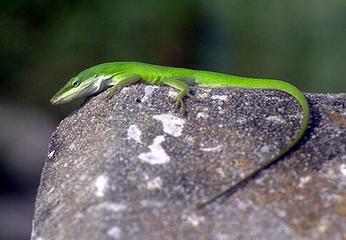RiskVA
Texas Anoles Are Not Chameleons 18 Jul 2007
When I was a kid – many years ago – I remember buying green lizards at the Texas State Fair in Dallas. Pitchmen had big flannel-boards covered with them. Each one had a little string leash with a safety pin on the end to attach your new friend to your shirt. Advertised as chameleons, they had the amazing ability to change color to match their background. Since they were usually displayed on green flannel, their color was invariably bright green when purchased, but they definitely altered their appearance to approximate the color of my shirt.
Actually, those 6-8-inch reptiles I bought weren’t chameleons at all, even though some references call them “American chameleons.” They are really anoles (Anolis carolinensis), sometimes called green anoles. Real chameleons are native to South America, Africa, and the Middle East with some two-thirds of them found natively only on the island of Madagascar. Chameleons change color depending on their mood and the hue of the surface under them, as do anoles, but they are longer and bulkier and have the strange ability to move their eyes independently to focus each one on a different object, giving them the appearance of needing eye muscle surgery. Their eyes also bulge outward allowing them to rotate so much they can see ahead with one eye and behind with the other.
The lizards I bought at the fair are native to Texas, the entire southeastern United States, Central, and South America, and islands in the Caribbean. These slender, speedy lizards are tree dwellers that feed on insects such as crickets, roaches, moths, grubs, and spiders. Their water needs are met both from their food and by licking dew or water droplets on vegetation when it rains. Color changes are largely limited to grayish-brown, brown, and various shades of green.
Anoles are common throughout East Texas and I recently saw one perched on our mailbox. One or two also hang out near our back door. They seem to like brick walls and rocks, probably because they are cold-blooded and those warm surfaces help them remain active in cooler weather. Cold-blooded animals don’t generate metabolic heat by oxidizing food as we do and are, to a great extent, at the mercy of the outdoor environment and air temperature. When conditions are unfavorable, either too hot or too cold, they shelter in dead leaves, under rocks and logs and other protected locations. Like Goldilocks' porridge, conditions must be “just right.”
Male anoles have an expandable skin flap under their chin and chest called a dewlap. Like a small, bright pinkish or reddish fin or sail, they expand the dewlap when courting (“Ain’t I handsome, honey?”) or to ward off territorial intruders (“I’m bad; git lost dude!”).
A number of animals dine on anoles, including birds, snakes, other lizards, raccoons, some rodents, and a wide variety of other predators. Domestic cats prey on them too and can pose a severe threat to their numbers. With so many enemies, the anole’s ability to modify its color helps it to stay hidden. A particularly interesting adaptation is the lizard’s very fragile tail. If an attacker isn’t fast enough to grasp the lizard’s body, all they are left with is a mouthful of still-squirming tail that snapped off during the assault. The anole then grows a replacement tail, although it is often shorter than their original issue model.
In Texas, these interesting animals breed from late March through early October, laying a single white egg on the ground in leaf litter. It will hatch in 5-7 weeks leaving the newborn lizard on its own, for better or for worse.
Look for them around your house. They are beneficial in controlling insect pests, well-adjusted to living in close proximity to people, and I like to think of them as friendly, although their tiny reptile brain likely doesn’t compute at that level.
In any case, most of the lizards bought at the State Fair undoubtedly died because owners had neither the knowledge nor the desire to take care of them properly. Mine were turned loose after a few days and I like to think they went happily about their lizardine lives hardly worse for the “wear!”
Dr. Risk is a professor emeritus in the College of Forestry and Agriculture at Stephen F. Austin State University in Nacogdoches, Texas. Content © Paul H. Risk, Ph.D. All rights reserved, except where otherwise noted. Click paulrisk2@gmail.com to send questions, comments, or request permission for use.

